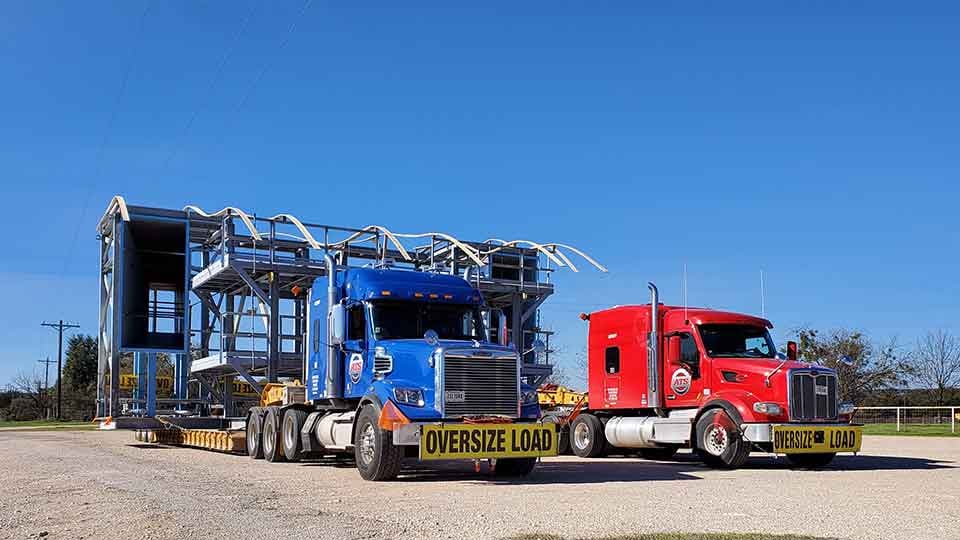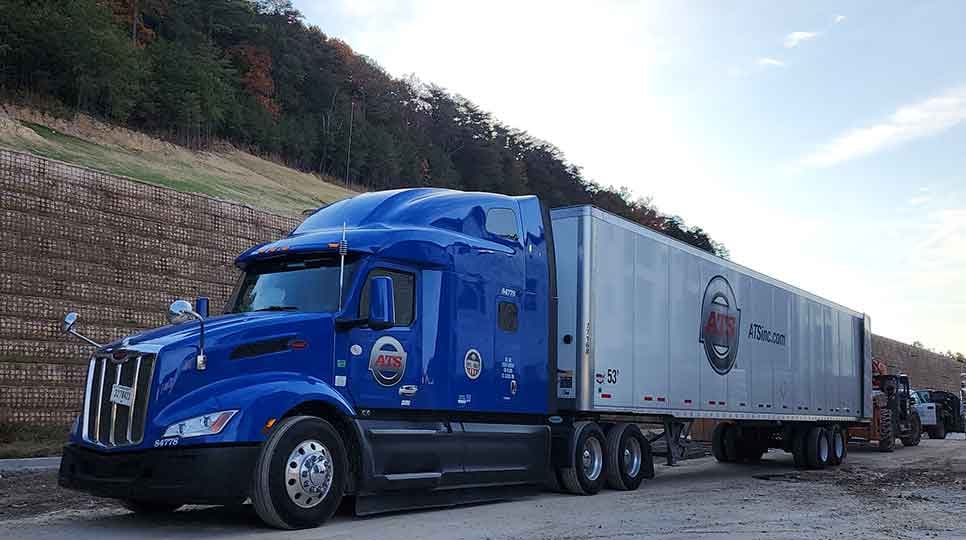Shipping goods across the country, and especially from overseas, is rarely as simple as loading the material once at the origin point and then unloading it at the final destination.
Most shipping, whether from one truck to another or to a completely different mode of transportation, requires transloading.
But what is transloading? How is it done, and is it required for all transportation projects? Is transloading always required to move freight from Point A to Point B? Who coordinates all the needed vehicles and equipment?
After 68 years in the transportation industry, we at Anderson Trucking Service (ATS) have transloaded thousands of shipments. While not every load is the same, coordinating transloading projects typically follows a basic framework. You can complete a successful project with a relatively simple understanding of the process.

To help ensure your shipment arrives at its destination on time and on budget, and help determine if transloading is right for your project, read on to learn:
- What Is Transloading?
- When Is Transloading Required?
- What Are Alternatives to Transloading?
- What Are the Disadvantages of Transloading Freight?
- How Should You Choose a Transloading Provider?
- How to Get the Best Quote for Transloading Services
What Is Transloading?
Transloading, often confused with cross-docking, is the process of taking material from one vehicle, sorting and repalletizing it, and then loading it onto another vehicle.
Transloading can be multi-modal, for example moving freight from a rail car to a dry van for transport to its ultimate destination, or it can be moving freight from one truck to another to plan more efficient transit routes.
Hundreds of companies offer transloading services in the U.S. alone. All these options can make it overwhelming to choose the best one for your needs. But there are a few qualifiers you should look for that will contribute to the best transloading experience for you and your precious cargo.
When Is Transloading Required?
Transloading freight may be required for several reasons, including cost savings and convenience. Here is a list of 5 reasons companies, like yours, may consider transloading their product:
1. Transloading helps cargo stay underweight.
Dividing freight from one larger shipment (like out of a full container) into two (or more!) truckloads is an easy way to make sure the shipment stays under the required legal size or weight limits.
2. Transloading reduces containerized shipping costs when your final destination is far from the port.
When your consignee is located far from the port, it can be impossible to deliver freight and unload it from its container with enough time to return the container to the port within the three to five days allowed before detention costs kick in. Transloading can help.
By transporting the container to a nearby transloading station and then loading it to a different vehicle, you can avoid the high fees charged by the port for late container return – even if you are able to backhaul freight to the port, it is typically less expensive to transload than to make a round trip of several hundred miles.

3. Transloading allows large shipments to be delivered to multiple end-points.
If a large amount of inventory is arriving from overseas, it can be transloaded to multiple smaller vehicles to transport to warehouses or retailers in different parts of the country.
4. Transloading saves money when crossing the border.
Taking a load of freight over international borders requires additional paperwork and expertise, and some shipping companies will not cross certain borders due to cost and safety concerns. Transloading freight at a domestic point near the border can reduce the overall cost and concern of crossing the border.
5. Transloading gets freight back on the road when the unexpected occurs.
In case of a truck breakdown or accident that causes a time delay, transloading the freight to another vehicle can get your shipment back on the road much faster.
When transloading is required, there is no limit or restriction on the type of cargo that can be transloaded. Household goods, machinery and oversize items can all be transloaded. Oversize items especially are frequently disassembled, transloaded for on-carriage transport and reassembled at their final destination.
What Are the Alternatives to Transloading?
Like any shipping method, transloading isn’t right for every shipper and every trip. When transloading isn’t appropriate, alternatives include using a multi-modal shipping container or a third-party logistics provider.
Cross-Docking and Through Trailer Service
If crossing a land border, cross-docking (transferring freight from an inbound trailer to an outbound trailer at the border) or through trailer service (transferring a trailer to a different truck and continuing the journey) may be options. Cross-docking and through trailer service both eliminate the need for transloading at the border.
Transporting Freight in a Multi-Modal Shipping Container
A common alternative to transloading is keeping the freight contained within a multi-modal shipping container. This has the advantage of saving the time that would have been spent stripping a container, re-palletizing/arranging freight and loading another truck or set of trucks. This also eliminates the risks inherent in having freight damaged during the transloading process.
One disadvantage of this method when transloading a full container load is that a single truck might exceed legal load limits when tasked with hauling the entirety of a container’s contents. In this situation, you’ll need to book multiple on-carriage solutions, increasing your costs.
Additionally, when transloading your cargo — particularly when using an under-resourced logistics provider — you risk delays in returning your container to its port.
Offloading Freight Using a Third-Party Logistics Provider
Another way to avoid transloading is to offload freight in a warehouse and then use a third-party logistics (3PL) provider to carry the freight to its ultimate destination. If a warehouse and 3PL are available this may be a good option, but it can be difficult to add more moving pieces to the shipping process.
What Are the Disadvantages of Transloading Freight?
Discussion of advantages and disadvantages of transloading is often irrelevant (it’s something you either need or don’t need). Nevertheless, there are 2 main reasons customers may avoid transloading.
- Risk of cargo theft or damage. Because transloading is done by human hands, it introduces some risk of damage or theft to your freight. This risk can be mitigated by using a trustworthy and reliable transloader, and by having your freight properly insured, but there is always a chance it could still happen.
- Inventory management. Adding a step to the supply chain process introduces a risk that your inventory will be offline or untrackable for a few days.
Choosing a Provider of Transloading Services
When managing your supply chain, it’s critical to ensure the transloading partner you choose is effective and reliable. You may be able to use one provider to carry and transload the freight, or you may choose different providers. Transloading can be done by a carrier or a third-party logistics provider hired specifically for the loading.
Either way, don’t wait until the last minute to vet the entity providing transloading services. Before planning your cargo’s route, make sure you are selecting the providers every step of the way. Here’s what you should consider:
Proximity to Port Is Critical
When it comes to transloading, the best provider just might be the closest provider. Shaving even a few miles off the distance between the transloading location and the port of origin can result in big cost savings.
Proximity to the port means fewer drayage miles for your freight, resulting in big cost savings for this segment of its journey. For example, a drayage company that can use the same driver for six trips to and from the port will be more economical than a company that can only get four round-trips from their driver in a day.
Because ports are often in metropolitan areas, traffic can have a huge impact on the time it takes to travel between the port and a transloading facility. Local facilities are easier to reach and more time efficient. This reduces your rates.
Ready to get started? Contact ATS for a quote.
Choose a Reliable Transloading Provider
When trusting a transloading provider with your freight, you should consider many of the same factors you would when vetting any other shipping company. Here are a few of them:
- Capacity. First, verify your company of choice has the ability to do the job you request. Many logistics companies provide only a handful of services and may not be able to provide transloading when and where you need it.
- Equipment and Technology. Ensure that your transloading provider uses safe, modern equipment at all stages of the transloading process. There is no universal standard for age and size of fleet, software used or loading equipment. However, ensure your provider has the equipment and technology needed to safely and efficiently handle and transport your cargo (where applicable).
- Availability. Look for a provider who will have assets available for transloading no matter where you need them.
- Credentials. If your transloading drivers will be accessing restricted areas like ports, be sure they have the required credentials. For example, all drivers will need a TWIC (Transportation Worker Identity Card) card, and many ports have additional access requirements as well. Make sure your provider understands and can fully articulate the requirements and their qualifications.
- Customer Service. Is your transloading company there to answer your questions, help you if something goes wrong and communicate with your staff throughout the process? If that’s important to you, verify they can provide the service you need.
Get the Best Quote for Transloading Services
When sourcing transloading services, you can help get the most accurate quote by providing complete information to your chosen providers. This will ensure you are making an apples-to-apples comparison, as well as eliminating surprises on your final invoice that weren’t reflected on your initial quote. Make sure to include:
- Point of origin. Where will the load originate? Be as specific as possible — don’t just specify a general port, specify the dock and address where the load will be picked up.
- Destination. Where will the cargo end up? Again, be as specific as possible with an address. It can also be helpful to specify if there will be a loading dock at the final destination so the driver knows what to expect.
- Quantity. How much freight will be transported where? What is the overall size and weight of your shipment? Will it be on pallets or otherwise separated? Make sure to share this information.
- Distribution. What needs to end up where? This will help your provider plan for handling and scheduling.
- What services are needed? Will you be requiring drayage and handling, just drayage, returning containers, or something else? Even large transloading providers that offer all these services may not specify them unless asked.
- Timeline. When will your cargo be ready for pickup? What is the deadline for delivery? Is there any flexibility to those dates?
Once you have written your request using these qualifications, it can be helpful to compare multiple transloading providers. Consider price, timing and each provider’s reputation when comparing them. You may also want to reach out to others in your industry or area to find the name of a reliable company that offers transloading and logistics services.
Don’t leave your important inventory to just any transloading company. Once you have identified a need to transload your cargo, take the time to find a provider in the location you need, who provides the services you require and has the necessary equipment. Take the time to create a precise request to ensure you are getting the best quote before you get started. This will help protect your cargo to keep your supply chain and project on track!
When overseeing a transportation project, transloading can seem like a daunting step. But understanding what transloading is, why it may be necessary and how it is accomplished can help ease your mind and make the project go more smoothly. Are you ready to take the next step? Check out the ATS Freight Shipping Calendar to learn more about the timing of transloading shipments.




